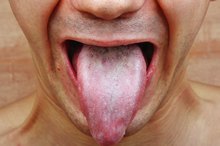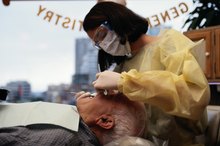What are the causes of pale gray and swollen gums?
The human mouth is the first site of digestion, where teeth and saliva begin the breakdown of food. For this reason alone, you should try to keep your teeth in the best possible condition. According to the Centers for Disease Control, there are also links between oral health and a person’s general health. Lesions or other problems in the mouth may be the first indicator of a systemic problem. Infections in the mouth can also make their way to the bloodstream, causing serious systemic infections. Often these problems are visible in the mouth, in the form of gray or swollen gums.
Trench Mouth
Trench mouth, also called Vincent’s Infection or acute necrotizing ulcerative gingivitis (ANUG), is caused by naturally occurring bacteria in the mouth that overgrow and cause an infection in the gums, according to Merck Manuals. As the infection progresses, the gums erode and may bleed. A layer of dead, gray cells is visible on the surface of the gums. Pain and bad breath are almost always present, sometimes with swelling of the lymph nodes in the jaw or a mild fever. The disease was first described during World War I, when soldiers in the trenches developed the infection. Now the disease is relatively rare, occurring mainly in individuals with compromised immune systems.
Leukoplakia
Diseases and Disorders of the Tongue
Learn More
According to the WebMD article “Dental Health and Leukoplakia,” leukoplakia presents as a white or gray spot on the inside of the cheeks, or on the gums, tongue or roof of the mouth. It is usually painless but may be sensitive to temperature changes or spicy foods. Leukoplakia is caused by an irritation to the soft tissues of the mouth, perhaps by a crown, filling or dentures. Leukoplakia may also be caused by smoking, sun exposure to the lips, HIV or AIDS and, rarely, oral cancer. A biopsy is usually performed to rule out cancer.
Amalgam Tattoos
Gray/blue spots on the gums, cheeks, tongue or roof of the mouth can also be caused by the amalgam used in certain dental procedures. Simple Steps to Better Dental Health states that the amalgam metal in fillings, crowns or caps can be pressed into the soft tissues of the mouth during dental procedures or rub into the tissues slowly over time. Amalgam tattoos themselves are not dangerous, though a dentist or oral surgeon will need to confirm that the mark is a tattoo and not a precancerous or cancerous lesion.
Oral Melanomas
What Do Black Spots on Gums Mean?
Learn More
According to the Oral Cancer Foundation, oral melanomas are rare. These cancers of the melanocytes (melanin-producing cells) occur rarely in the mouth, because there are few melanocytes located there. Typically, oral melanocytes present on the palate (roof of the mouth) or on the upper gums. These cancerous lesions are often blue/black in appearance. The lesion may be overlooked or misdiagnosed, leading to a late detection of the disease. Due to detection in late stages of the cancer, the survival rate for oral melanomas is less than two years. These melanomas are more common in people of Japanese descent, males, and individuals over 40.
Prevention and Treatment
While not all causes of gray gums can be prevented, good oral hygiene can prevent trench mouth. Merck Manuals describes the treatment of trench mouth as a thorough, professional dental cleaning, often followed by hydrogen peroxide rinses. Antibiotics may be necessary, depending on the extent of the infection. Leukoplakia is treated by removing the source of the irritation to the soft tissue. This may mean the removal of fillings or crowns. Treatment for oral melanomas is usually surgical, to remove the cancerous lesion.
Amalgam tattoos do not require treatment, though a patient may choose to have them removed for cosmetic reasons. It is important, however, that possible amalgam tattoos be ruled out for cancer, especially if there is any change in size or color over time. Any gray lesion on your gums or elsewhere in your mouth should be checked by a dentist or oral surgeon for a proper diagnosis.
Related Articles
References
Writer Bio
Susan McGrath has been writing since 2004, mostly creative nonfiction. She is a regular contributor of science-related articles to various websites. McGrath has a Bachelor of Science in wildlife biology and a Master of Science in cell and molecular biology, both from Colorado State University.









